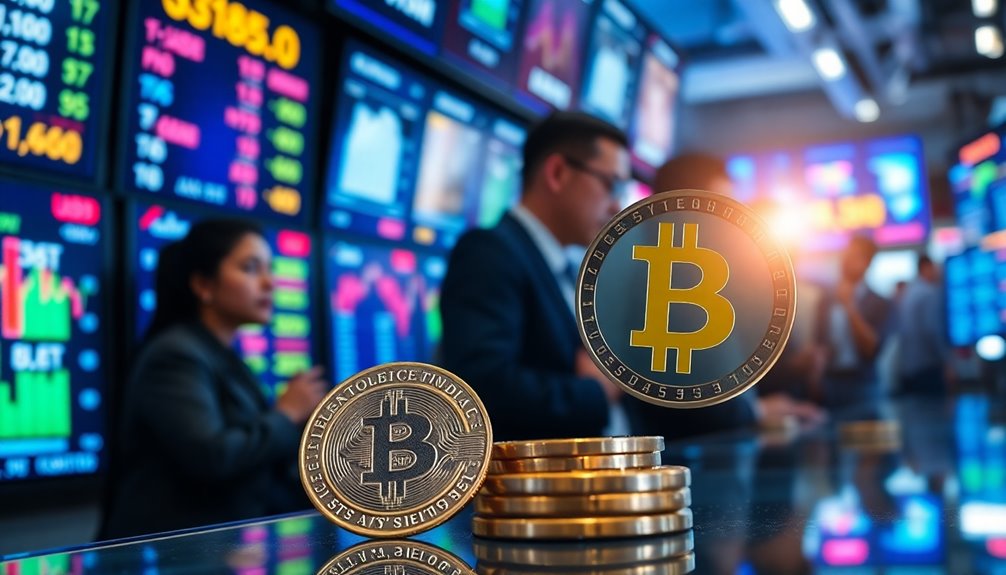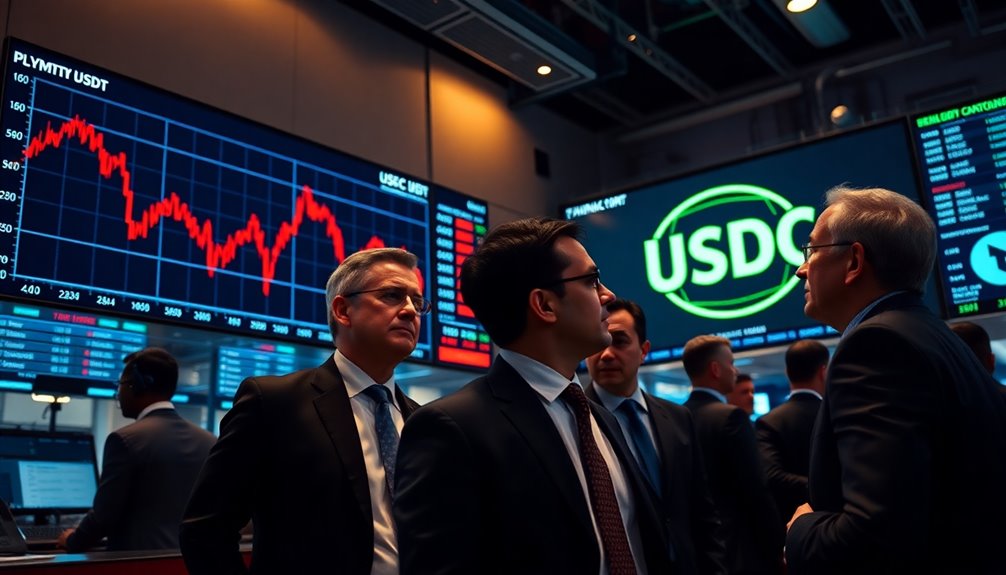You might have noticed the shifting dynamics in the stablecoin market, particularly with USDT's declining dominance. The introduction of MiCA regulations seems to favor compliant stablecoins like USDC, which has recently gained market share amid increasing regulatory scrutiny. As Tether's market cap shrinks and USDC rises, it raises questions about the future of these digital currencies. What implications do these changes hold for investors and the broader cryptocurrency landscape? The answers could reveal more than just numbers; they might reshape your understanding of stability in the crypto world.
Key Takeaways
- USDT's market share on centralized exchanges fell from 82% to 74%, indicating a decline in dominance.
- USDC's market share increased to 12%, bolstered by its compliance with MiCA regulations.
- Tether's market cap decreased from $141 billion to $137.5 billion due to increasing regulatory pressures and delistings.
- Regulatory changes favor compliant stablecoins like USDC, enhancing its appeal and adoption among corporate investors.
- USDC's strong growth reflects a shift towards stablecoins with regulatory approval, challenging Tether's position in the market.
Stablecoin Market Dynamics Shift

As the stablecoin landscape evolves, you might notice a significant shift in market dynamics, particularly with USDT's declining dominance. Its market share on centralized exchanges has dropped from 82% to 74%, mainly due to rising competition from stablecoins like USDC and FDUSD. USDC has surged to a record 12% market share, bolstered by its regulatory compliance under the EU's MiCA regulations. Meanwhile, Ripple's RLUSD is rapidly gaining traction, thanks to its robust payment infrastructure. As major exchanges prioritize compliant stablecoins, Tether faces challenges that could further erode its market presence. With increased demand for regulatory clarity, the stablecoin supply is set to double, indicating a transformative phase in this evolving market. Notably, the total stablecoin market capitalization reached $200 billion in 2024, reflecting the growing investor interest and usage in this segment.
Regulatory Changes Impacting USDT

With the impending implementation of the EU's MiCA regulations, USDT faces a critical juncture that could reshape its market position.
By December 30, 2024, stablecoin issuers must hold 60% of their reserves in EU banks, a requirement Tether struggles to meet. This has led to significant redemptions and exchanges like Coinbase and OKX delisting USDT for European users, pushing its market cap down from $141 billion to $137.5 billion. Meanwhile, USDC has gained traction, securing MiCA approval and increasing its market share. The stablecoin market is anticipated to expand rapidly, driven by increased institutional adoption and trading activities.
Tether's ongoing compliance issues and lack of full audits have fueled mistrust, allowing competitors like RLUSD to capitalize on the situation.
If Tether doesn't adapt, its dominance could further erode.
Stablecoin Volatility and Adoption Rates

Stablecoin adoption and volatility are reshaping the landscape of digital currencies, significantly influencing market dynamics. You'll notice that USDT's dominance is waning as competitors like USDC and FDUSD gain traction. Recently, USDC's supply surged by $954 million, surpassing USDT's growth of $792 million. Regulatory changes favor compliant stablecoins, making USDC and FDUSD more appealing. In regions like Latin America and Sub-Saharan Africa, stablecoin transfers are skyrocketing, while institutional investors in North America embrace stablecoins for liquidity management. Additionally, DAI boasts the highest transaction velocity among stablecoins, highlighting its decentralized appeal. As these trends unfold, you'll see a notable shift in market share, with USDT potentially dipping below the 50% threshold. The rise of stablecoins is also driven by their role in decentralized finance (DeFi), providing essential liquidity and services that traditional finance cannot match.
Corporate Investment Strategies

Given the evolving landscape of the digital currency market, corporate investment strategies are increasingly focusing on aligning financial decisions with national security priorities.
The FY2025 Investment Strategy emphasizes strategic capital allocation, categorizing investments by their national security impact. Critical technologies take center stage, leveraging insights from the commercial sector. This portfolio approach ensures investments are spread across various competition arenas and timeframes, establishing a clear strategic direction.
Simultaneously, regulatory compliance is shaping the market dynamics. With MiCA regulations in play, firms are adapting to comply, steering clear of non-compliant options like USDT. The increased supply of USDC further demonstrates its growing acceptance among corporate investors.
As USDC secures regulatory approval, it positions itself as the leading stablecoin, reflecting a shift in corporate strategies toward compliance and national security alignment.
Election Cycles Affecting Market Trends

The interplay between election cycles and market trends significantly influences investor behavior and stock performance.
Pre-election and election years typically yield the highest returns, as political uncertainty wanes. You'll notice that the three months following an election often bring substantial gains, thanks to optimism around new policies. Additionally, the historical pattern of volatility shows that increased fluctuations are observed prior to elections.
The first year of a new presidency usually offers the best market performance, driven by investor confidence in upcoming fiscal measures. Conversely, volatility spikes in the lead-up to elections but often settles afterward.
Understanding these cyclical patterns can help you strategize your investments and capitalize on periods of growth, particularly during the last two years of a presidential term when the market tends to flourish.
Regulatory Landscape Shaping Stability

As regulatory frameworks evolve, they're reshaping the landscape of the cryptocurrency market, particularly for stablecoins.
The EU's MiCA regulations, set to be implemented by December 30, 2024, require stablecoin issuers to hold 60% of reserves in EU banks. This has placed USDT in a challenging position, with its market cap declining from $141 billion to $137.5 billion amid delistings by exchanges like Coinbase and OKX. In fact, nearly $4 billion in USDT(4 billion in USDT) was redeemed prior to the implementation of MiCA regulations, marking the largest outflow since 2022. Additionally, maintaining high-quality content is vital for attracting and retaining user trust during such regulatory transitions.
Meanwhile, USDC has gained traction, securing MiCA approval and seeing its market cap grow by $2 billion.
With new entrants like Ripple's RLUSD offering compliant alternatives, the competition is heating up. As investors shift towards more transparent options, stablecoin issuers must adapt to survive in this evolving landscape.
Frequently Asked Questions
What Is the Difference Between USDT and USDC?
When comparing USDT and USDC, you'll notice key differences.
USDT, launched in 2014, dominates the market with higher liquidity and more trading pairs, making it popular among traders.
On the other hand, USDC, launched in 2018, emphasizes transparency and regulatory compliance, conducting monthly audits.
While USDT is widely used globally, USDC is gaining traction in DeFi and is preferred by institutions for its adherence to regulatory standards.
How Do Interest Rates Affect Stablecoin Investment?
Imagine watching a seesaw, with interest rates rising and falling like the tide.
When rates climb, stablecoin issuers can invest your assets for higher profits, enhancing their revenue.
Conversely, when rates drop, the income from their Treasury holdings shrinks, possibly forcing them to seek alternative reserves.
For you, these fluctuations might affect the stability and value of your investments, as inflation risks loom larger over longer holding periods.
Stay vigilant!
Are There Risks Associated With Stablecoin Use?
Yes, there are several risks associated with stablecoin use.
You face market and liquidity risks, where sudden redemption spikes can lead to asset fire sales.
Operational risks arise from cyber-attacks and the complexity of the crypto ecosystem.
Financial stability is at stake if a stablecoin's outflows disrupt funding markets.
Lastly, future regulatory uncertainties and market volatility can further complicate your investments, making it essential to remain aware of these potential threats.
How Do Stablecoins Influence Traditional Banking?
So, you think traditional banks are snug as a bug in a rug? Think again!
Stablecoins are shaking things up, turning credit provision on its head. By replacing cash with digital assets, they streamline cross-border transactions, making your life a whole lot easier.
Plus, they're pushing banks to innovate. Sure, regulatory frameworks are vital, but without them, banks might just be left wondering how to keep up with this digital revolution!
What Role Do Exchanges Play in Stablecoin Liquidity?
Exchanges play a crucial role in stablecoin liquidity by facilitating trading and providing access to various stablecoins.
When you trade on an exchange, you're tapping into its liquidity, which impacts how easily you can buy or sell stablecoins. A stablecoin's presence on multiple exchanges enhances its liquidity, attracting more users.
If an exchange delists a stablecoin, like USDT in some regions, it can lead to decreased trading volumes and reduced market confidence.
Conclusion
In the ever-shifting sands of the stablecoin market, USDT's grip is loosening as USDC steps into the spotlight, bolstered by MiCA's favorable winds. As regulations tighten their embrace, USDC's rise feels like a phoenix ascending from the ashes of uncertainty. If USDT doesn't adapt, it risks becoming a relic of the past, overshadowed by a more compliant and robust contender. The tide is turning, and the future looks bright for those who play by the rules.









